What is Tanuki Udon?
Tanuki udon is a Japanese noodle dish and a variation of “kake udon.” Kake udon is a dish consisting of udon noodles served in a hot dashi broth. While “kake udon” is the general term, the actual name of the dish changes depending on the toppings. A few examples of kake udon are:
- Kitsune udon
- Tsukimi udon
- Tempura udon
- Tanuki udon
Tanuki udon, in particular, is topped with flakes of deep-fried tempura batter known as “agadama” (揚げ玉) or “tenkasu” (天かす) and chopped spring onions, but the toppings can vary from region to region.
For this reason, depending on where you go in Japan, the name “tanuki udon” can produce different results!
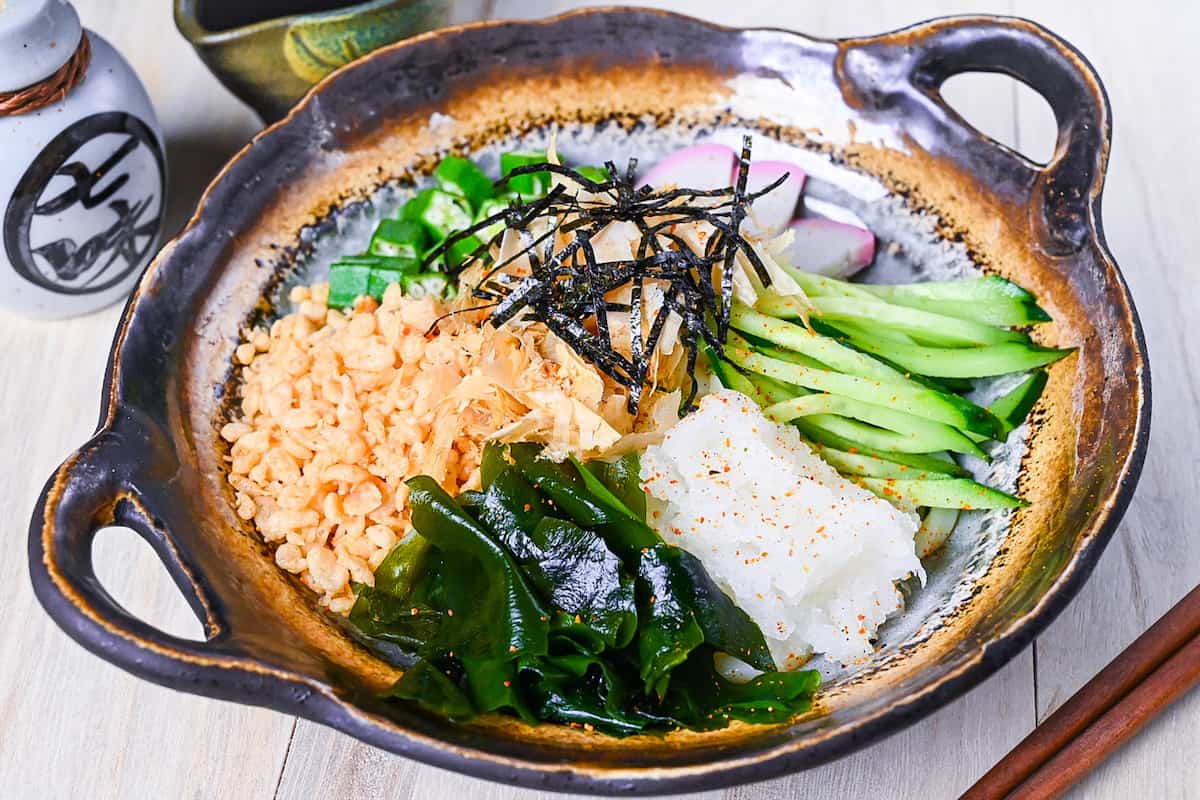
Ingredients & Substitution Ideas
- Dashi Broth – The backbone of flavor. I’d recommend simple awase dashi or vegan dashi, for quicker options, instant dashi granules or packets work perfectly fine.
- Soy Sauce – For brand recommendations, check out my detailed soy sauce guide.
- Mirin – For maximum authenticity, use hon-mirin (本みりん).
- Sugar – Ordinary white sugar is A-OK, but I personally prefer the deeper flavor of light brown cane sugar.
- Udon Noodles – These satisfyingly chewy wheat noodles are essential. Depending on your needs, you can choose pre-boiled, dried, or frozen udon. Wanna try some fun weekend project? Check out my homemade udon noodles recipe!
- Toppings – Consider tempura flakes (tenkasu), kamaboko fish cake, julienned Japanese or Persian cucumber, okra, grated daikon radish, wakame seaweed, bonito flakes (katsuobushi), sesame oil, shredded nori seaweed, and wasabi paste.
Here, I will list all the alternative ingredients, substitutions, and variations to make the hiyashi tanuki udon to your preference.
- Soft boiled eggs
- Firm or silken tofu
- Benishoga pickles
- Chopped green onion
- Grated ginger (instead of wasabi)
- Shiso leaves
- Tomato
- Crab sticks (instead of kamaboko)
You can substitute or omit ingredients depending on your preference and what is available to you!
Jump to Full Recipe Measurements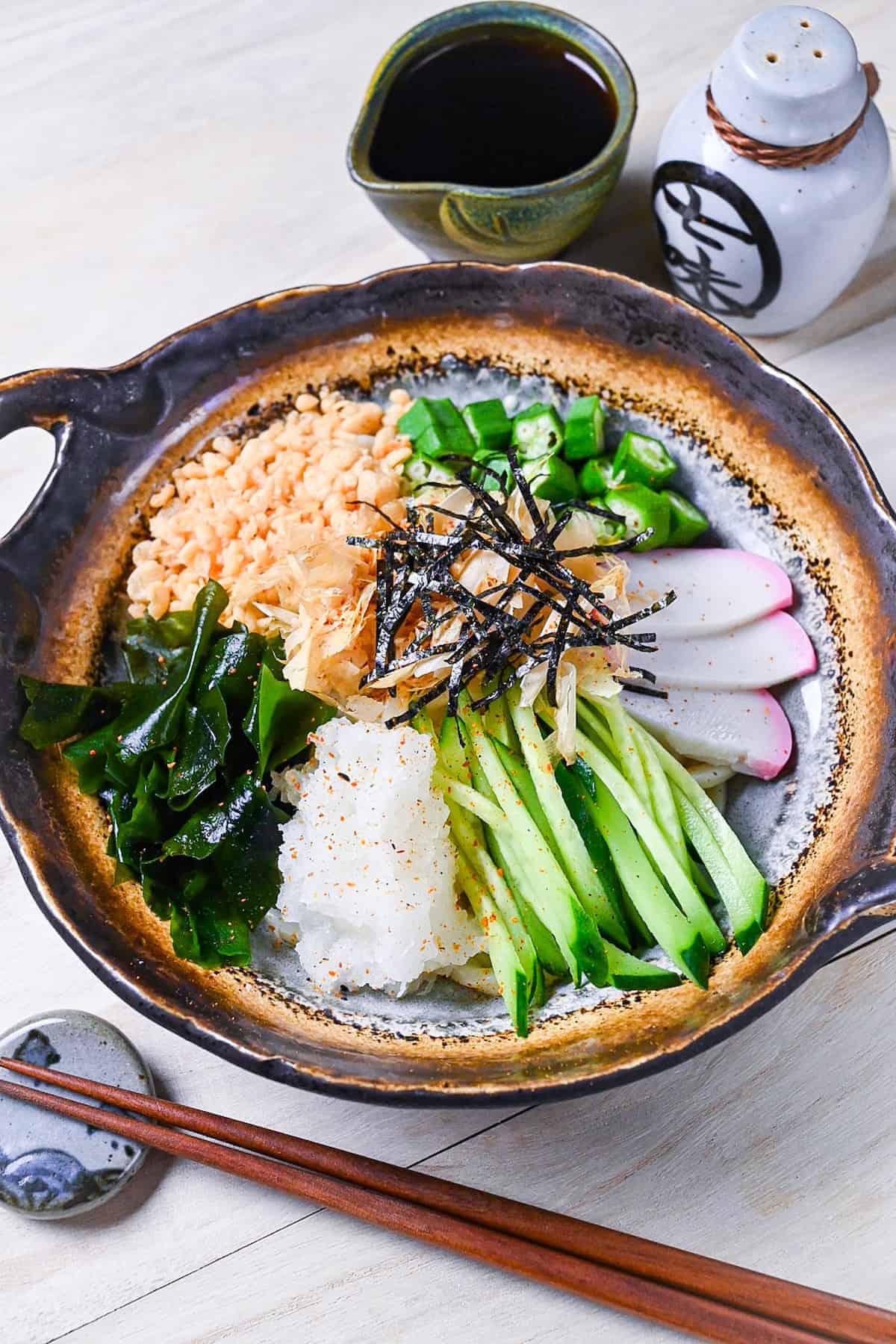
Visual Walkthrough & Tips
Here are my step-by-step instructions for how to make Hiyashi Tanuki Udon at home. For ingredient quantities and simplified instructions, scroll down for the Printable Recipe Card below.
The sauce for this recipe is made with just 4 ingredients: dashi, soy sauce, mirin, and brown sugar. Simply boil them in a saucepan for a few minutes to melt the sugar and burn off the alcohol in the mirin; that’s all there is to it!
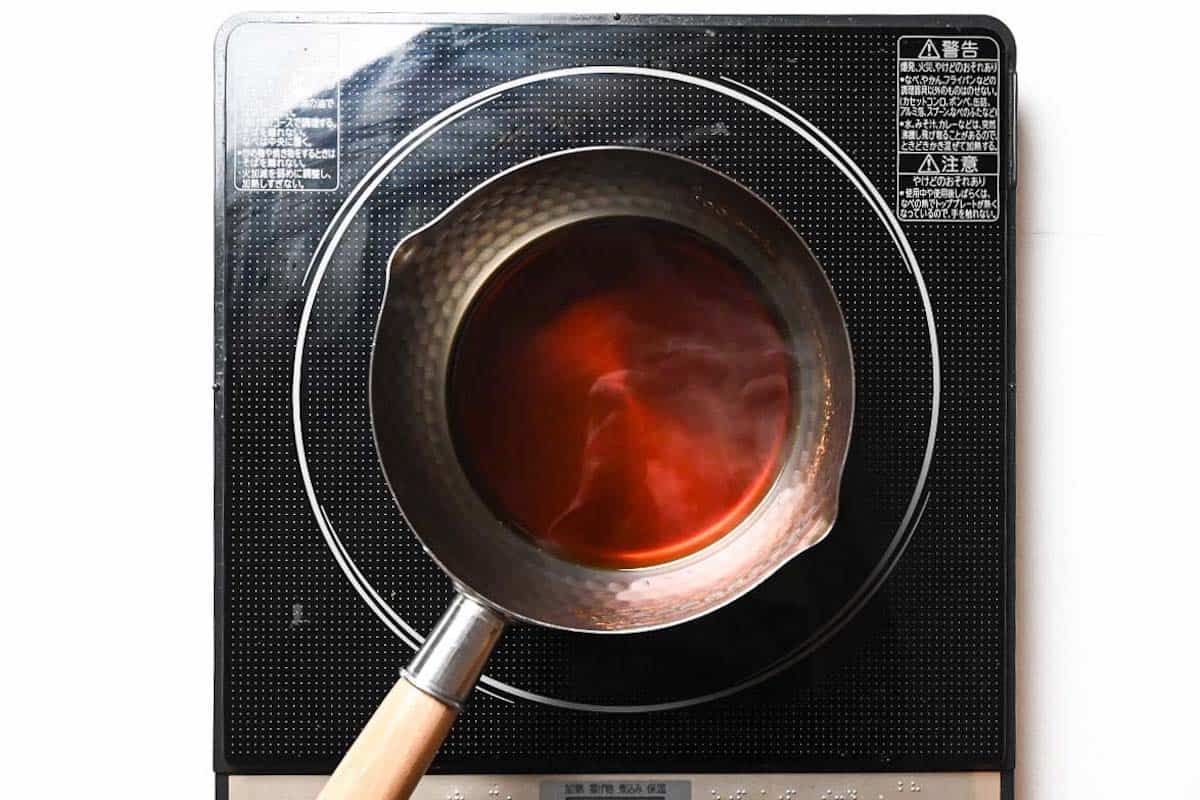
It’s a concentrated sauce, so I like to cool it quickly with a couple of ice cubes, but you can add a little bit of cold water instead if you don’t have any ice readily available.
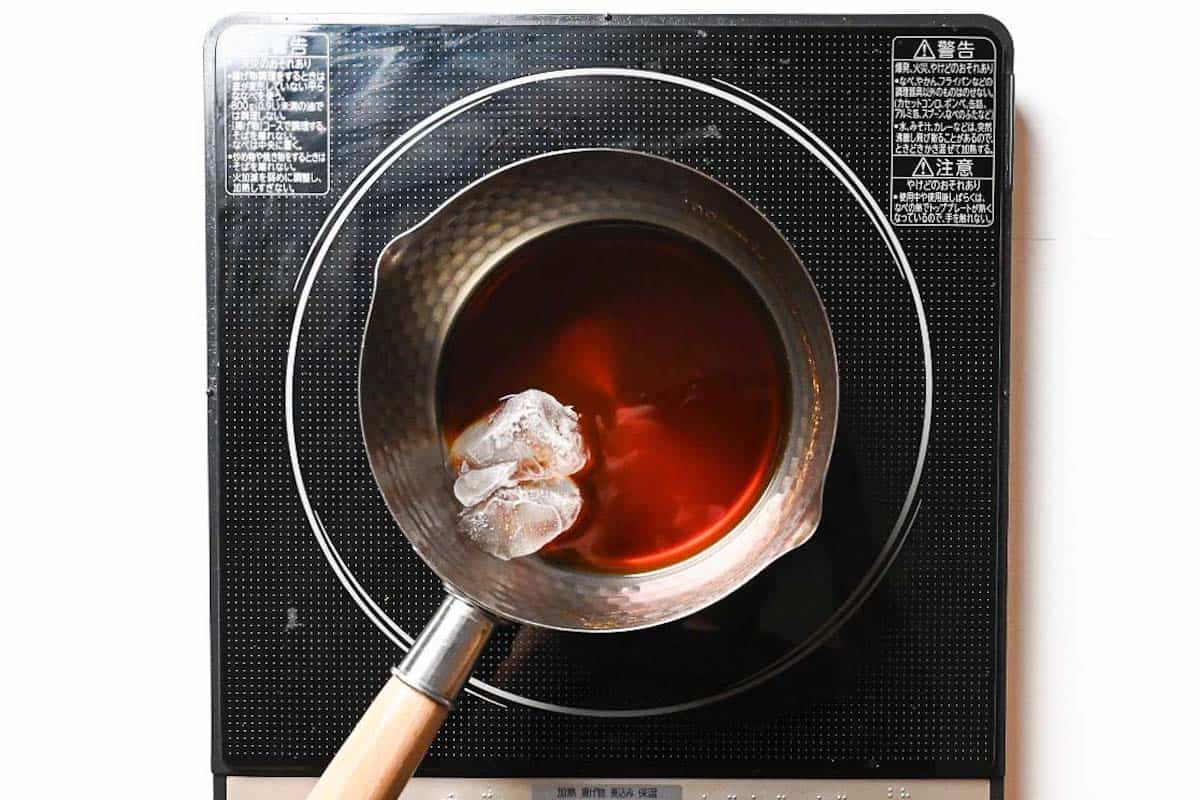
For a hiyashi tanuki udon sauce suitable for vegetarians, simply use a vegetarian dashi stock. I have a recipe for kombu and shiitake dashi here!
Cooking times vary depending on what kind of udon you use. I personally always use frozen udon for its great texture and the fact you can cook it in the microwave, but of course, dried or chilled udon is also fine to use. Just follow the cooking instructions on the packaging.
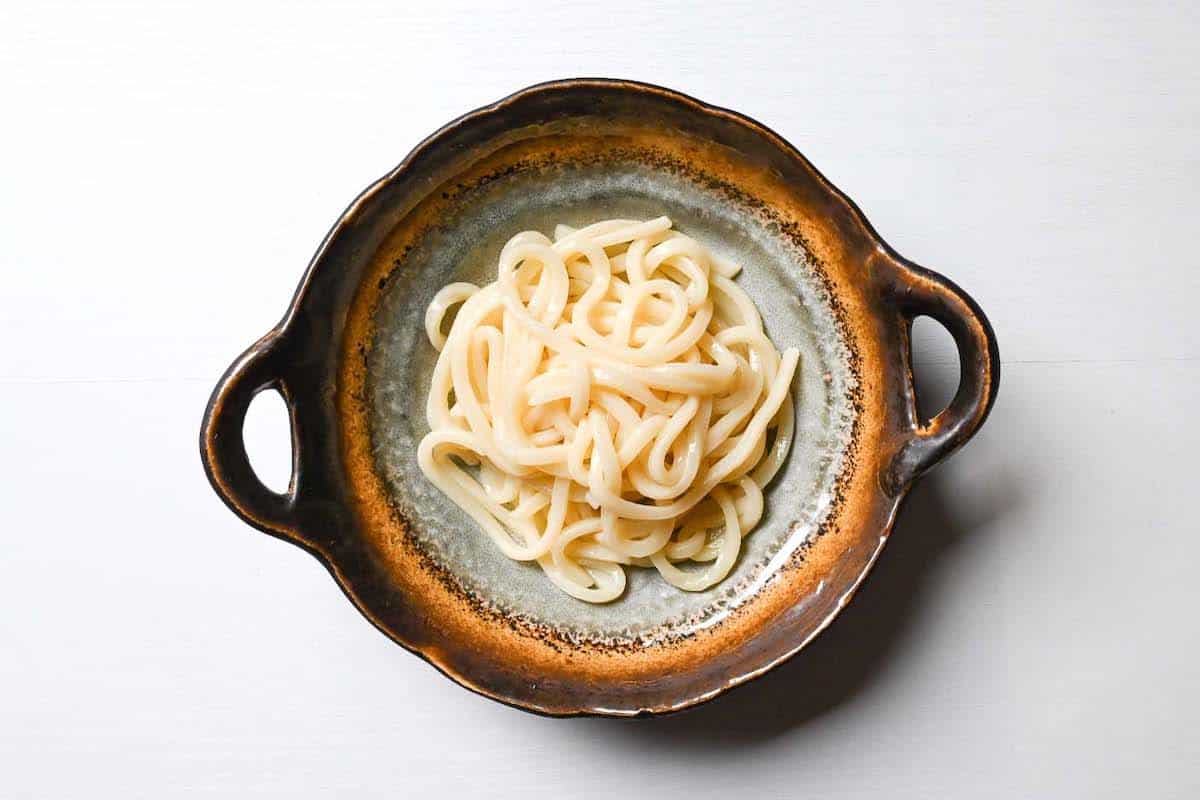
To cool it quickly and remove excess starch, pour the cooked udon into a colander over the sink and wash with cold running water. Although this step cools them down quickly, it doesn’t make them cold, so I like to add a few ice cubes to the noodles while I prepare my toppings.
For nicely chilled udon noodles fast, wash with cold water and leave them in a colander with a few ice cubes for 5 minutes. (Place the colander over the sink or a large mixing bowl to catch the melting ice.)
Grated daikon radish (oroshi daikon) is a common addition to many Japanese dishes due to its slightly peppery yet refreshing taste.
But, did you know that grating daikon is important to grate the right part? The bottom of the daikon (the point) is strong and bitter, which is best used for pickles or strongly flavored soups or hotpots. The middle part is sweeter and great for simmered dishes. Finally, the top part near the stem is mild and best for eating raw in salads or as oroshi (grated). It’s also better to peel the outside of the daikon before grating.
For the most pleasant flavor, be sure to use the top part of the daikon when making daikon oroshi (grated daikon radish).
Because the toppings will be mixed in with the noodles, I recommend cutting everything thin and fine for best results. The toppings you choose affect the texture of the dish, so to balance the chewy noodles and soft, sauce-soaked tenkasu, I recommend choosing a few crunchy toppings with some bite (I used okra and cucumber).
If, like me, you use wakame for this dish, soak it according to the instructions on the packaging.
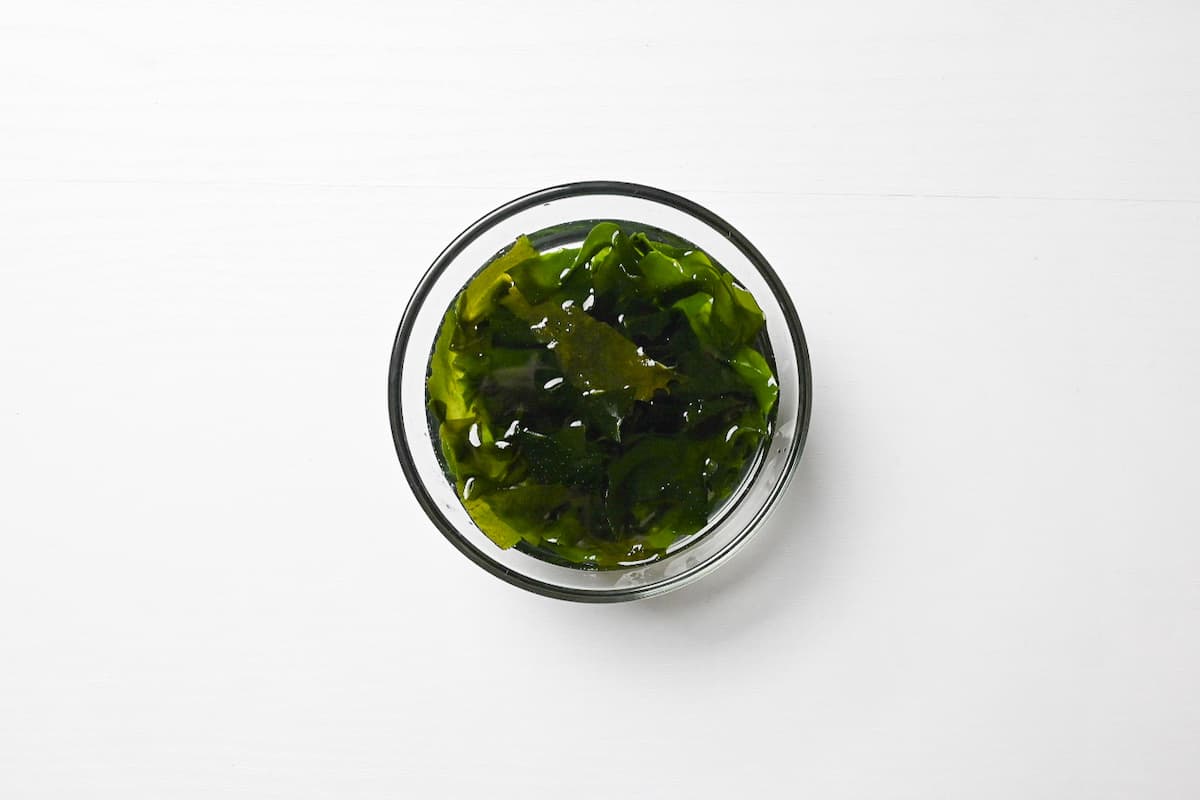
Once all of your ingredients are ready, place a portion of the udon noodles in each bowl.

Arrange the ingredients beautifully on top of the udon, feel free to get creative here!
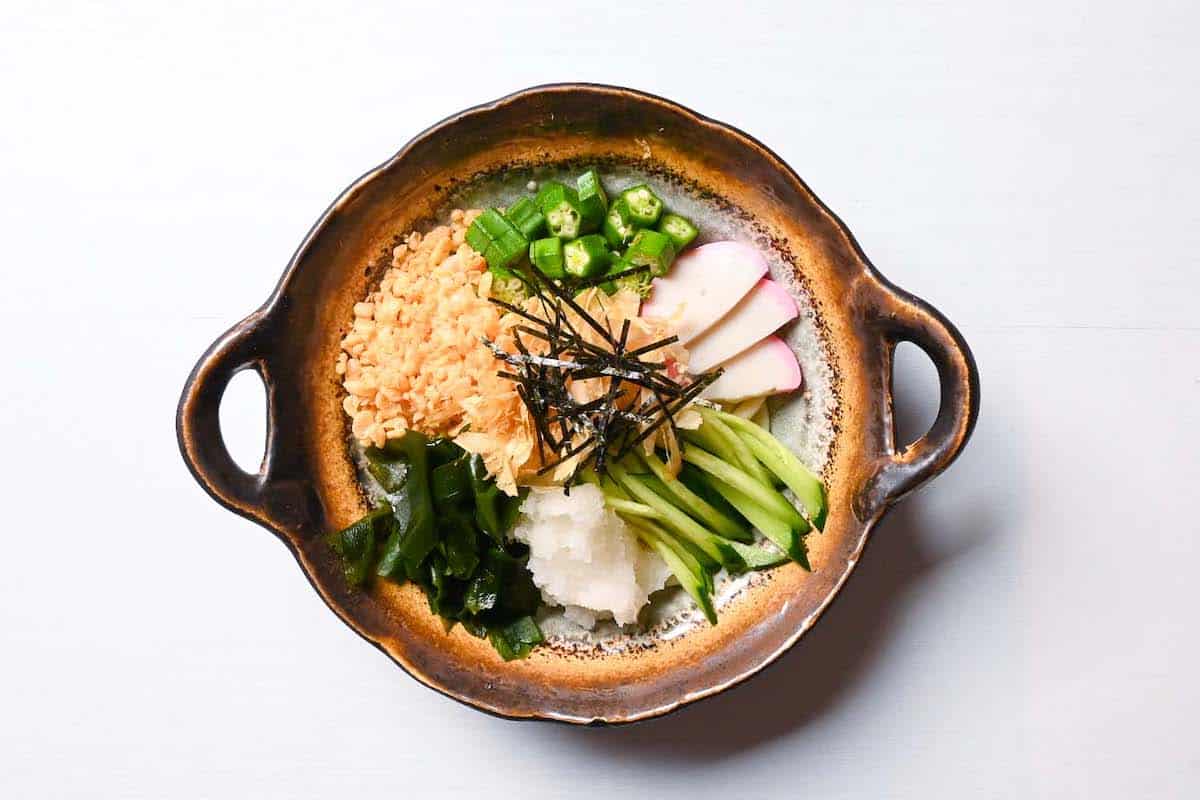
The final step is drizzling the toppings with sesame oil (which adds flavor and makes them easier to mix) and then pouring the sauce over the top! Make sure to divide the sauce equally between portions.
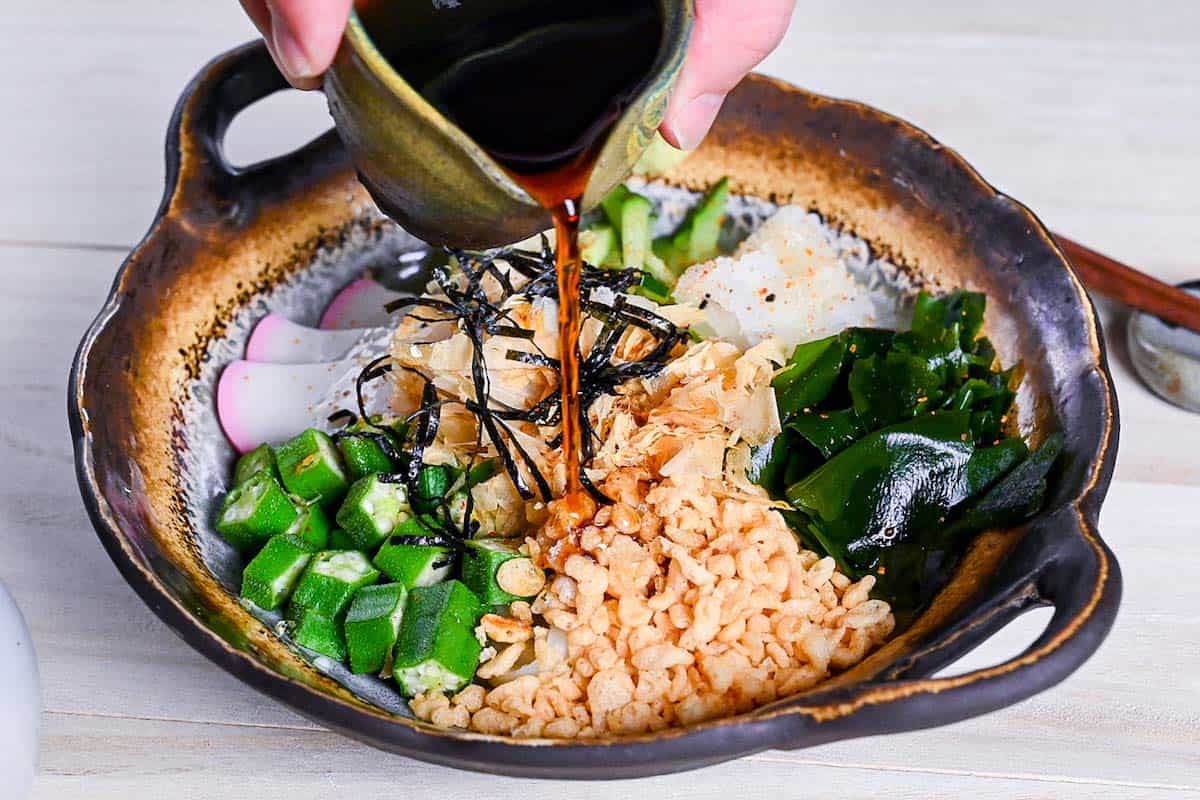
If you love food with a spicy kick, feel free to add a touch of wasabi to the side of the dish. You can use this for dipping or mix it in with the sauce!
Mix thoroughly before eating and enjoy!
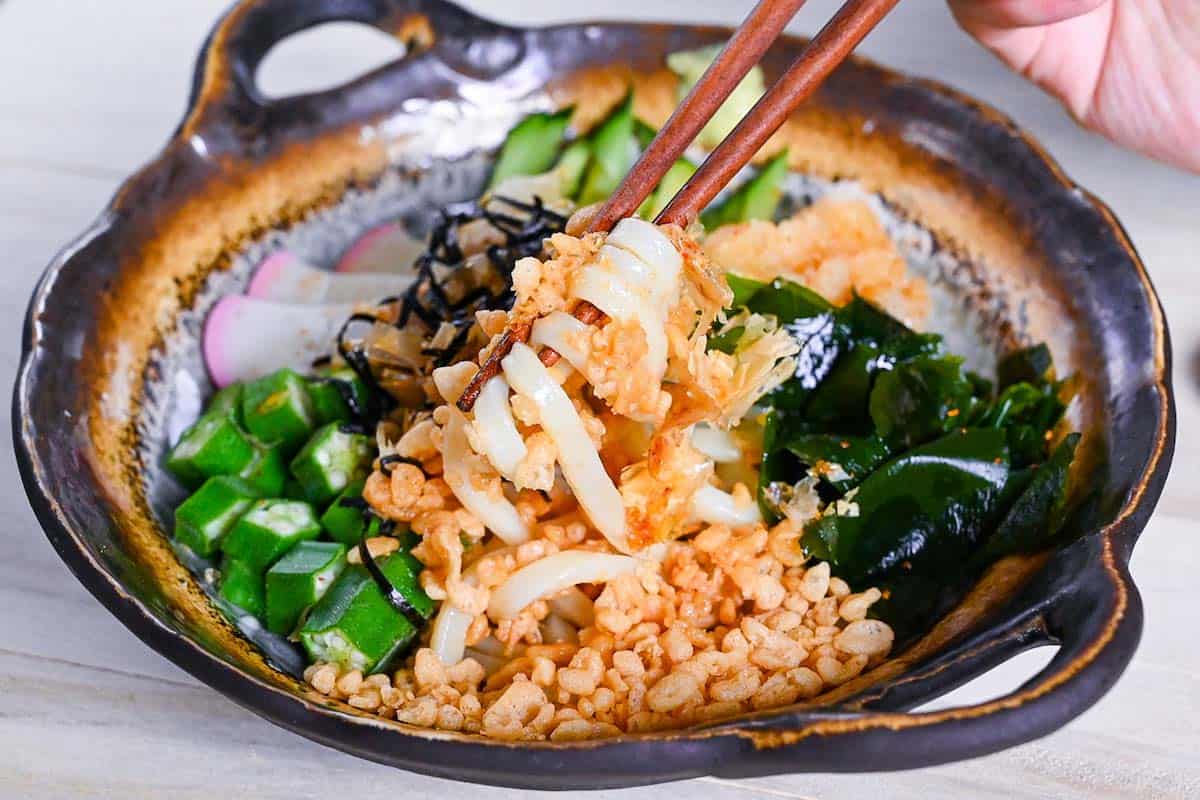
I hope you enjoy this Hiyashi Tanuki Udon recipe! If you try it out, I’d really appreciate it if you could spare a moment to let me know what you thought by giving a review and star rating in the comments below. It’s also helpful to share any adjustments you made to the recipe with our other readers. Thank you!
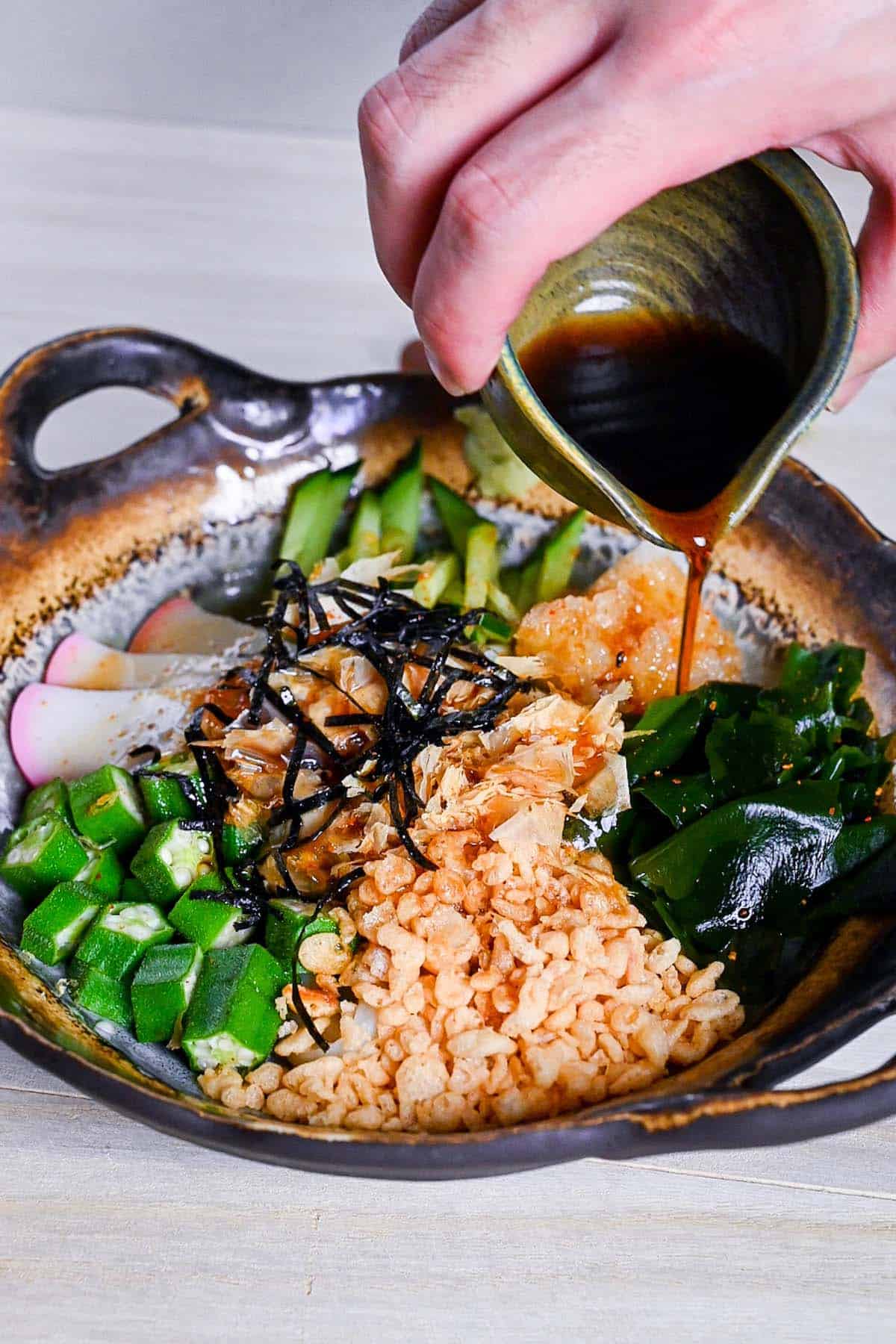
More Japanese Udon Dishes
- Zaru Udon (Cold Udon with Homemade Dipping Sauce)
- Shrimp Tempura Udon Noodle Soup (Ebiten Udon)
- Kitsune Udon (Udon Noodles with Deep Fried Tofu)
- Tsukimi Udon
Want more inspiration? Explore my Udon Roundup Post for a carefully selected collection of tasty udon recipe ideas to spark your next meal!
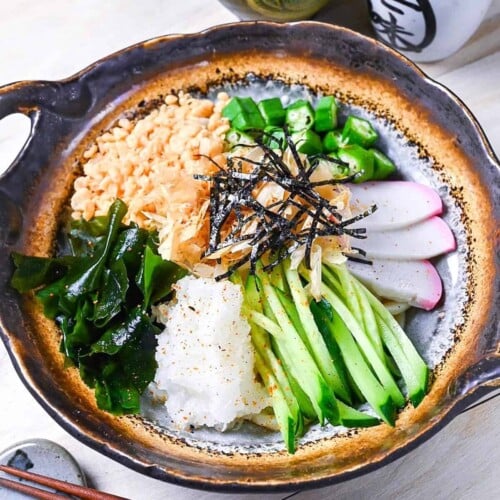
Hiyashi Tanuki Udon (Cold)
Equipment
- Yukihira saucepan
Ingredients
Sauce
- 2 tbsp dashi stock (or equal amount of water with a pinch of dashi gradules) use shiitake and kombu dashi for plant-based diets
- 1 ½ tbsp Japanese soy sauce (koikuchi shoyu)
- ½ tbsp mirin
- ½ tsp light brown sugar
- 2 ice cubes or 3 tbsp cold water
Noodles and Toppings
- 2 portions cooked udon noodles
- ice cubes to chill the udon
- 2 tbsp tempura flakes (tenkasu)
- 6 slices kamaboko fish cake optional, omit for plant-based
- 50 g Japanese cucumber julienned
- 40 g okra sliced
- 2 tbsp daikon radish grated
- 1 tbsp dried wakame seaweed
- bonito flakes (katsuobushi) optional garnish, omit for plant-based
- toasted sesame oil optional garnish
- kizami nori (shredded nori) optional garnish
- wasabi paste optional garnish
My recommended brands of ingredients and seasonings can be found in my Japanese pantry guide.
Can’t find certain Japanese ingredients? See my substitution guide here.
Instructions
- Mix 2 tbsp dashi stock, 1 ½ tbsp Japanese soy sauce (koikuchi shoyu), ½ tbsp mirin and ½ tsp light brown sugar in a saucepan and bring to a boil on a medium heat. Allow to boil for 1-2 minutes and then remove from the stove.

- Add 2 ice cubes to the sauce to cool it quickly. Once cool, store in the fridge until serving time.

- If using wakame, soak according to the instructions on the packaging. (Usually about 5-10 mins.)

- Cook the udon noodles according to the instructions on the packaging. Once cooked, pour them into a colander and wash with cold running water. Place a bowl underneath and add a few ice cubes to the noodles. Leave to chill for 5 minutes.

- Prepare your toppings according to the instructions in the ingredient list. Divide the udon into serving bowls and arrange the toppings on top.

- Add a small amount of wasabi to the side of the bowl (optional) and drizzle with sesame oil. Finally, pour the chilled sauce over the top.

- Mix thoroughly before eating and enjoy!

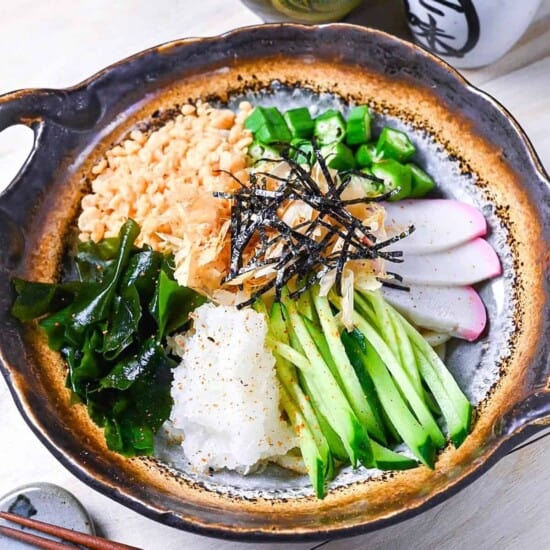


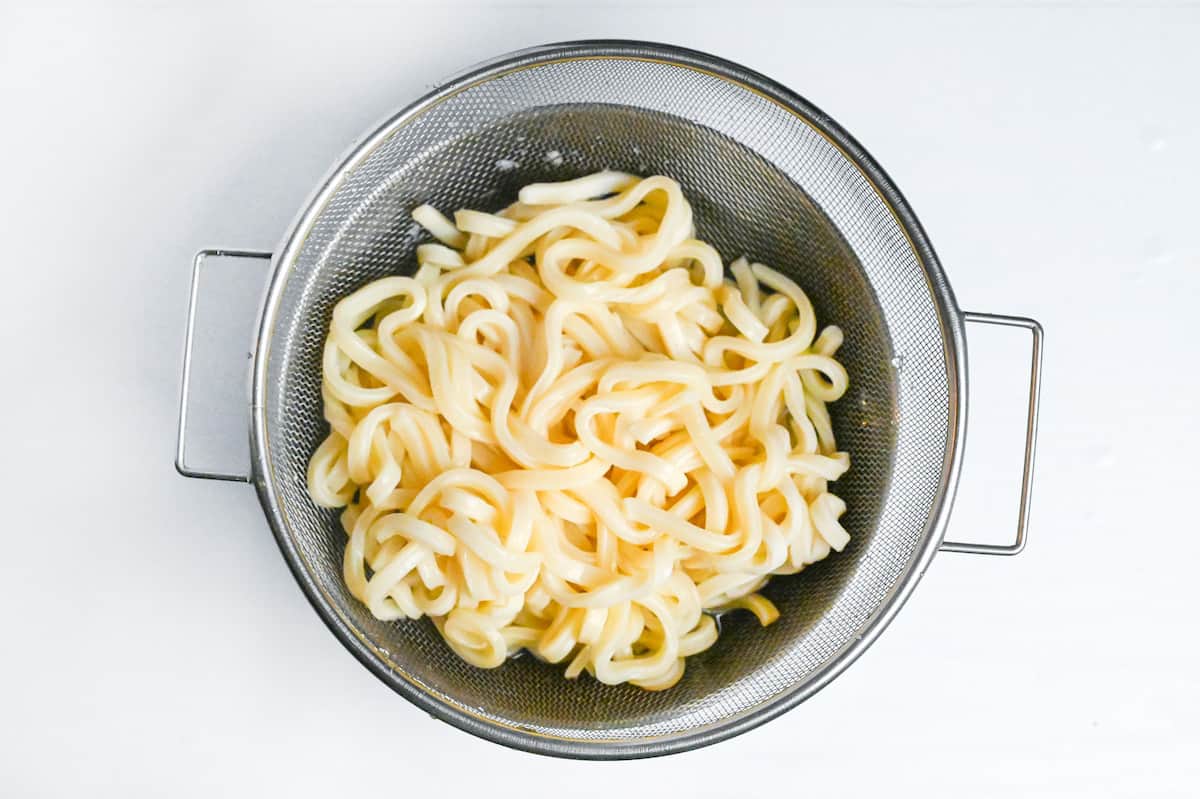
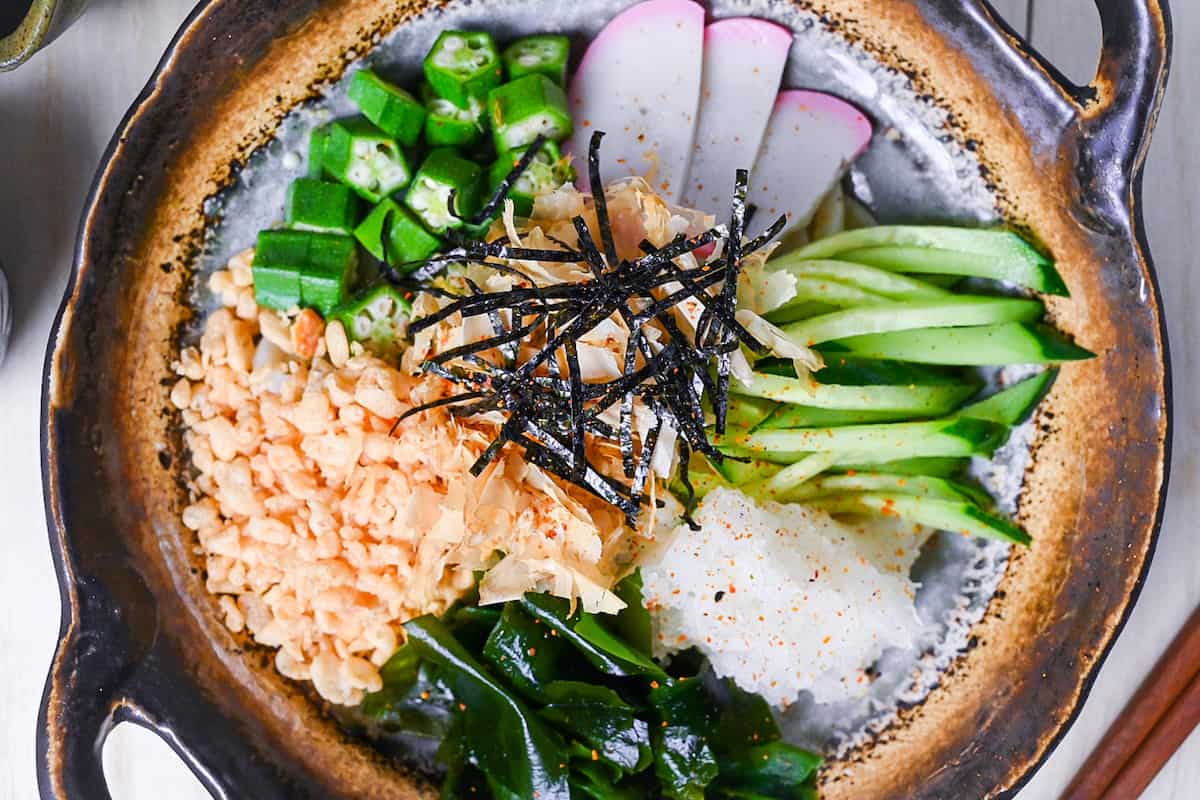
Leave a rating and a comment